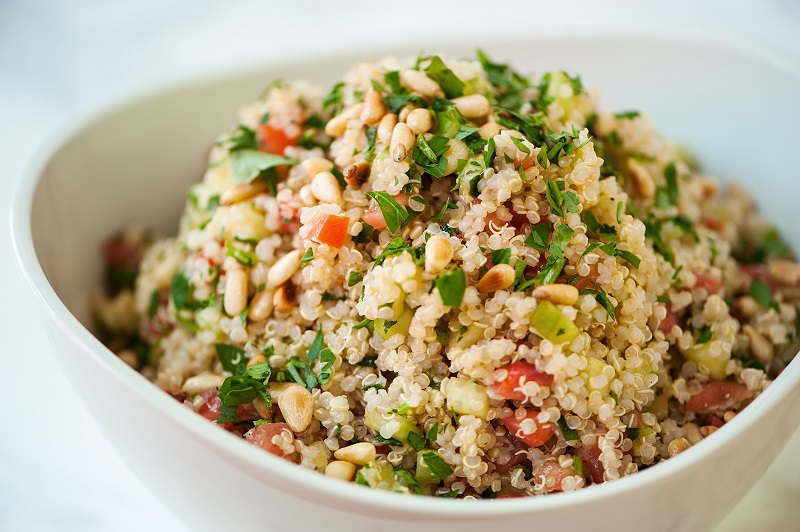Gluten has become a part of our daily lives, and sometimes it seems almost impossible to prepare a meal that does not contain it, but gluten-free grains are the best option. However, people diagnosed with celiac disease should eat gluten-free foods, which is why one of the most nutritious foods is gluten-free grains, which are also part of very healthy diets.

What are gluten-free diets?
Gluten-free diet regimens generally involve avoiding grains, especially foods that are rich in gluten. The gluten-free diet does not necessarily mean that you should stop eating grains, and that is good news since grains are an excellent source of fiber and nutrients, which are essential for our digestion and there are many of them gluten-free.
The most nutritious gluten-free grains
We suggest you read this summary of nine gluten-free grains. A famous nutritionist, presents nine gluten-free grains to include in your diet. The best thing about these grains is that they are easy to prepare, super delicious and nutritious, just try to go for organic grains that today can already be found in health food stores or in some popular supermarkets, since you should know that grains, Whether whole or ground and gluten-free, in the form of cereals to consume with milk, or in bars, breads, flours, etc., they are contaminated with large amounts of chemicals that were used as diet foods.
Amaranth
Amaranth originated in South America, and is rich in fiber and vitamin C. It is excellent for people who are struggling with celiac disease, due to its ability to positively influence the rebuilding of the entire digestive system and in addition to being a gluten-free grain.
For a complete breakfast, you can combine 1/3 cup amaranth and 3/4 cup gluten-free oatmeal. Add a little salt to season, and pour in 4 cups of water. Let it cook for half an hour.
Buckwheat
Buckwheat is a traditional peasant dish. It is rich in calcium and B vitamins. It has a distinctive and full flavor and is often prepared as a porridge. To prepare the buckwheat porridge, cook over low heat for 15-20 minutes. Add a little butter or olive oil, and a little sea salt if possible. In this way you will take advantage of the benefits of another very nutritious gluten-free grain.
Corn
Both corn and cornmeal are rich in fiber, vitamin C, and vitamin A and are gluten-free. If you have suffered from celiac disease and need to renew your cells and the amount of vitamin A in the body, polenta / cornmeal is the right thing for you.
We must bear in mind that the market is flooded with genetically modified corn and it may be wiser to opt for grits from a local farmer.
Corn can be prepared and consumed in many different ways, including polenta. Polenta is a very tasty and nutritious corn-based food, and it can be served as a garnish for almost any specialty. Semolina can also be used as a flour, so make a delicious crust for a crunchy pizza or whatever else you want.
Son
Millet is often marginalized, and is not widely used today. However, millet is very nutritious and easy to digest, it is quite cheap, profitable, and rich in potassium. Furthermore, millet can regulate the pH in your body and therefore help maintain the acid-alkaline balance throughout the body.
To prepare a good dish, use a cup of millet. Add 2-3 cups of water, and simmer for thirty minutes. Millet can be prepared as a flan as well. Cook some millet in combination with fruit juices and water (4 cups) for 45 minutes to an hour.
Quinoa
Quinoa has recently become one of the most popular grains. It is rich in iron, protein and also gluten free, and is used largely by people who do not eat meat or animal products. Cook a cup of quinoa and three cups of water for 10 minutes and enjoy all the benefits of a great gluten-free without equal, which will help you treat digestive problems and for people who want to be fit, it is also very beneficial for people who suffer from diabetes.
Oatmeal
Many people around the world start their day with an oatmeal. Oats are very rich in fiber and protein and are gluten-free. This grain is gluten-free, but during the process, there is a chance that it will be “infected” with gluten, so be sure to look for products labeled gluten-free.
The recipe for oatmeal is quite similar to the recipe for any other grain. Cook a cup of oatmeal and 3/2 cups of water for 15 minutes (depending on the thickness you are looking for).
Rice
It has been widely used for centuries. It is rich in thiamine and gluten free. If you want to choose basmati rice, it will take longer for your body to digest. For more fiber, go for brown rice, it should cook a little longer than regular rice.
Cook one cup of rice and two cups of water for a little over ten minutes. To prepare brown rice, cook a cup of grain and 2 to 3 cups of water. It will take 45 minutes to an hour.
Sorghum (Chinese sugar cane)
Sorghum is not as popular as other grains considered gluten-free. Many people probably don’t even know that sorghum can be eaten as a grain. Sorghum can be included in a wide variety of recipes and its contribution of antioxidants that help the body against various diseases, including heart problems. It is recommended to include in the diet of celiac because it is a great gluten-free and full of nutrients.
*Note. Oatmeal that is labeled “gluten-free” should be sourced to ensure that it is pure oats, and not contaminated with gluten.
